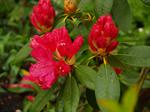 Rhododendrons are grown commercially by semi-hardwood, nodal, heel or leaf bud cuttings in mid autumn. Stem cuttings of some hybrids have also been successfully taken in mid-winter. Plants grown from cuttings are generally free of suckering which can be common with grafted plants.
Rhododendrons are grown commercially by semi-hardwood, nodal, heel or leaf bud cuttings in mid autumn. Stem cuttings of some hybrids have also been successfully taken in mid-winter. Plants grown from cuttings are generally free of suckering which can be common with grafted plants.
Cuttings are taken approximately 5 -10cm long for small leaved types up to 25cm or so for larger leaved types, with all but 2 or 3 top leaves removed. If leaves are very large, they may be cut in half. The better cutting material is taken from the more shaded parts of the stock plant. Wound the cuttings removing two 2cm slices of bark from the base of the cutting, on both sides. Remove any flower buds. Treat the cutting with a fungicide and then treat with a rooting hormone such as IBA: Indolebutyric Acid. Then plant in pots of standard propagating mix, such as peat and sand. Plants should be placed on heated trays with a bottom heat at approximately 24 degrees centigrade. Mist is also desirable. With misting and bottom heat, plants are ready to lift in approx. 10 ‑12 weeks. Some difficult varieties can take up to twice this length of time to form roots. If left in a propagating bed too long, roots usually deteriorate.
Other Propagation Techniques
Unless you have very green fingers, propagating rhododendrons from cuttings can be very difficult to achieve and is best left to commercial growers. Rhododendrons can also be grown from seed and layering. They are not normally grown from seed as the plants hybridize readily and seedlings are usually different to their parents.
Layering is slow, with plants taking up to two years to root, but is the easiest and most successful method of propagating rhododendrons. This is achieved by selecting a branch which can be pulled down to the soil level. A cut is made part way through the stem and can be kept open by inserting a small twig. This part of the branch is then inserted just below the soil surface and pegged down or covered with stones to hold it in place for several months. After this, there should be a rooted stem section which can be removed from the parent plant. The new plant should be planted out during the winter.
It is also possible to propagate rhododendrons by air-layering. This technique again involves cutting a stem half way through. Firstly, leaves are removed around the area where the cut is to be made. A shallow upward cut is sliced into the stem and dusted with hormone rooting powder. The cut may once again be separated with a small twig or object. Damp sphagnum moss is then packed around the wound and this can be held in place with string or elastic bands. Polythene sleeving is then secured around the cut section to retain moisture. Rooting medium can be added before sealing the top end of the polythene. After several months the plant would have grown roots at the cut and the new plant can be removed from the parent and potted up or planted out.
Other methods include grafting onto seedlings of R. ponticum.
LEARN MORE ABOUT RHODODENDRONS
.
Contact us -Talk to an Academic Officer
We provide a FREE COURSE AND CAREER COUNSELLING SERVICE
Learn from our experience.